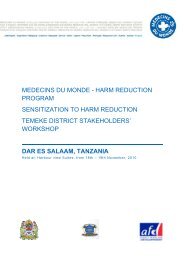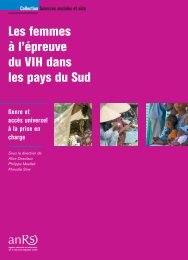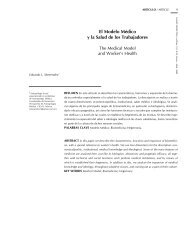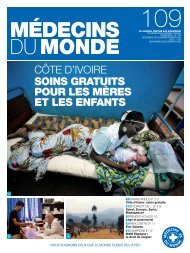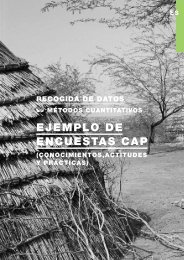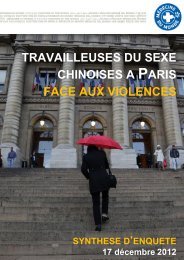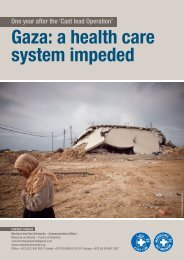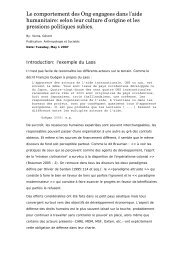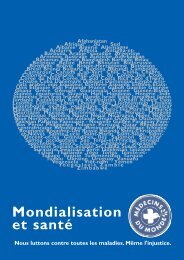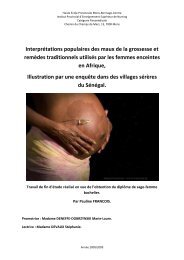Revue Humanitaire n°3 - automne 2001 - Médecins du Monde
Revue Humanitaire n°3 - automne 2001 - Médecins du Monde
Revue Humanitaire n°3 - automne 2001 - Médecins du Monde
Create successful ePaper yourself
Turn your PDF publications into a flip-book with our unique Google optimized e-Paper software.
3<br />
Thoughts for safety<br />
of aid workers in dangerous<br />
places. Lancet<br />
1999;354:609. Slim H.<br />
Doing the right thing:<br />
relief agencies, moral<br />
dilemmas and responsibility<br />
in political<br />
emergencies and war.<br />
Disasters<br />
1997;21:244.<br />
4<br />
Martin R. NGO field<br />
security. Forced<br />
migration Rev<br />
1999:4-7.<br />
5<br />
Schouten EJ, Borgdorff<br />
MW. Increased<br />
mortality among<br />
Dutch development<br />
workers. BMJ<br />
1995;311:1342-4<br />
Hargaten SW, Baker<br />
SP. Fatalities in the<br />
Peace Corps. JAMA<br />
1965;254:1326-9.<br />
Baker TD, Hargarten<br />
SW, Gutpill KS. The<br />
uncounted dead-American<br />
civilians dying<br />
overseas. Public Health<br />
Rep 1992;107:155-<br />
9. Frame JD, Lange<br />
WR, Frankenfield DL.<br />
Mortality trends of<br />
American missionaries<br />
in Africa, 1945-<br />
1985. Am J Trop Med<br />
Hyg 1992;46:686-90.<br />
Providing assistance while protecting the<br />
providers is the dilemma facing all international<br />
aid organisations 3 . To gain a better<br />
understanding of deaths in this group, we<br />
analysed 382 deaths in humanitarian workers<br />
between 1985 and 1998.<br />
Most humanitarian organisations believe<br />
that the number of deaths among relief<br />
workers has been increasing 4 . Although<br />
data exist for deaths among development<br />
workers, Peace Corps volunteers, and other<br />
expatriates, there have been no data on<br />
deaths among humanitarian workers 5 .<br />
Methods<br />
We collected information from the records of aid agencies<br />
and organisations. We included any death between 1985 and<br />
1998 occurring in workers in the filed or as a result of them<br />
having worked in the field <strong>du</strong>ring emergency or transitional<br />
periods. We classified organisations as non-governmental,<br />
Red Cross (the International Committee of the Red Cross,<br />
national Red Cross, or Red Crescent societies), United<br />
Nations programmes, and UN peacekeeping activities. Ethical<br />
approval for our study was given by the Committee on<br />
Human Research at the Johns Hopkins School of Hygiene<br />
and Public Health.<br />
Some organisations had no deaths or kept no<br />
records of deaths or their circumstances. Overall, 32 organisations<br />
and their affiliates provided data, with only three<br />
declining. We identified 392 deaths, of which 10 did not<br />
meet the inclusion criteria.<br />
Deaths were categorised by demography, occupational<br />
factors, and circumstances of death. We had hoped to<br />
calculate risk rates and ratios for national and expatriate<br />
humanitarian workers, but information about staffing levels<br />
that was needed to construct denominators was available<br />
from only a few organisations.<br />
Deaths were coded by cause. Deaths by intentional<br />
violence were those by means meant to inflict harm, such as<br />
45



